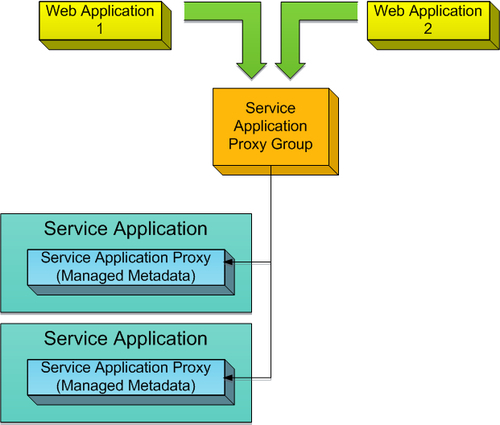Service application proxy
groups organize which service applications are consumed by a web
application. To make this functionality beneficial, it is recommended to
name these groups in a logical manner. In this recipe, we will create a
custom name for an application proxy group.
When creating a service application, it will
automatically be assigned to the default proxy group. Out of the box,
there are two application proxy groups:
It is possible to assign a service application to a custom proxy group. The benefit of creating custom proxy groups are:
Greater flexibility for creating a set of services for a web application.
More efficient use of resources such as hardware.
A
proxy group creates a service application proxy boundary. Web
applications cannot consume service applications associated with a
different proxy group. For instance, WebApp A is associated with proxy
group #1. This group has a finance-managed metadata service . Proxy
group #2 has a product-managed metadata service. In this setup, WebApp A
can consume only the finance-managed metadata service and not the
product-managed metadata service.
This is done through PowerShell. There is no user interface to create this component.
Getting ready
You must have local administrative permissions to the SharePoint 2010 web front-end (WFE).&; You must be a member of the SharePoint_Shell_Access database role on the configuration database. You also must be a member of the WSS_ADMIN_WPG local group on the chosen server.
How to do it...
Click the Start button on the WFE.
Under All Programs, navigate to the Microsoft SharePoint 2010 Products folder.
Right-click on SharePoint 2010 Management Shell and click Run as Administrator. The PowerShell console will appear. Type in the following command:
New-spserviceapplicationproxygroup name SAPGFinancial
The service application proxy group is created after submitting.
How it works...
Service application proxy groups are the ambassadors
of the service application technology. They match web applications to
the associated service application proxies. In this way, web
applications are consuming only those service applications that they
have access to.
An application proxy group can contain multiple
service applications, even of the same type (for example, two instances
of Excel Services). Refer to the following diagram:

There are two web applications utilizing the same
proxy group. The proxy group routes them to their service application
proxy group. In this case, there are two managed metadata service
applications.
There's more...
It is important to know what application proxy groups
are already in the farm. Getting a listing of these groups is done
through PowerShell. It may also be necessary to delete service
application proxy groups that are no longer necessary. The following two
PowerShell commands give you this ability: